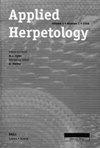A comparison of saltwater crocodile (Crocodylus porosus) populations in freshwater-floodplain and tidal river habitats of the Adelaide River catchment, Northern Territory, Australia
引用次数: 3
Abstract
Because they are subject to commercial harvesting, Crocodylus porosus populations in Australia are monitored to detect trends in their population growth. Monitoring programs are restricted primarily to estuarine waters with high crocodile densities, subsequently little information is available on populations in freshwater habitats. In this study I compared the body-size structure and minimum number of C. porosus known to be alive in tidal-estuarine and freshwater-floodplain habitats of the lower Adelaide River catchment, Northern Territory (N.T.) during the 2004 dry season. A total of 669 C. porosus was sighted. Of these individuals, 546 (81.6%) were sighted in tidal-estuarine waters and 123 (18.4%) were sighted in freshwater, floodplain billabongs and creeks. Crocodiles were observed up to 17.3 km from tidal waters. Crocodiles less than 1.2 m total length (TL) were the most frequently sighted size category in both the freshwater-floodplain (68%), and tidal river (31%) populations. Crocodiles 1.2-3.4 m TL comprised 62% of those seen in the tidal river but only 22% of those in freshwater floodplain habitats. Crocodiles >3.4 m TL comprised 10% and 6.5% of the sighted population in freshwater-floodplain and tidal river habitats, respectively. The body-size structure of C. porosus inhabiting the freshwater floodplain and tidal river habitats of the Adelaide River differed markedly from that observed in marine and freshwater river habitats where crocodiles less than 1.2 m are rarely encountered.澳大利亚北领地阿德莱德河流域淡水泛滥平原和潮汐河生境中咸水鳄(Crocodylus porosus)种群的比较
由于它们受到商业捕捞的影响,澳大利亚的鳄鱼种群受到监测,以检测其种群增长的趋势。监测计划主要局限于鳄鱼密度高的河口水域,因此淡水栖息地的种群信息很少。在这项研究中,我比较了2004年旱季在北领地(N.T.)阿德莱德河下游集水区潮汐河口和淡水泛滥平原栖息地已知活的C. porosus的体型结构和最小数量。共发现669只棘球蚴。其中546只(81.6%)出现在潮汐河口水域,123只(18.4%)出现在淡水、河滩滩和小溪中。在距潮汐水域17.3公里处发现鳄鱼。总长度小于1.2米(TL)的鳄鱼是淡水泛滥平原(68%)和潮汐河(31%)种群中最常见的体型类别。长1.2-3.4米的鳄鱼占潮汐河中鳄鱼总数的62%,而淡水洪泛区中鳄鱼总数的22%。在淡水泛滥平原和潮汐河生境中,鳄鱼的数量分别占看得见鳄鱼总数的10%和6.5%。生活在阿德莱德河淡水泛滥平原和潮汐河栖息地的C. porosus的体型结构与很少遇到小于1.2 m的海洋和淡水河流栖息地的鳄鱼明显不同。
本文章由计算机程序翻译,如有差异,请以英文原文为准。
求助全文
约1分钟内获得全文
求助全文

 求助内容:
求助内容: 应助结果提醒方式:
应助结果提醒方式:


